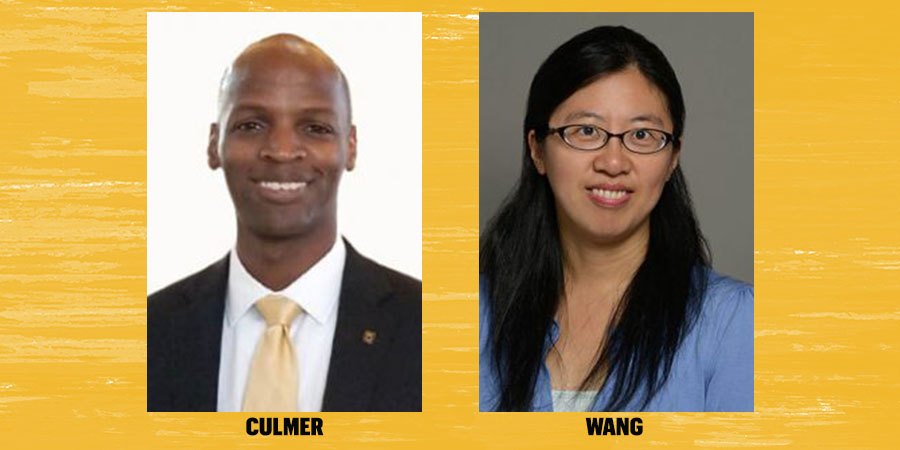November 16, 2021

Mizzou Engineering has created two new labs within the Information Technology Program designed to give students additional hands-on research opportunities. Kristofferson Culmer, assistant professional practice professor, is now director of the Autonomous Systems Lab, and Fang Wang, associate teaching professor, has been named director of the new Collaborative Research Environments for Extended Reality, or CREXR, Lab.
“These labs will further our mission to equip students with skills they need to succeed in emerging, technology-driven industries,” said Brian Maurer, associate professor of professional practice and director of the IT Program. “It really formalizes a lot of work we’ve been doing over the past year to prepare students for what’s coming in terms of autonomous systems, virtual and augmented reality and deploying technical solutions.”
In the Autonomous Systems Lab, students are working primarily on applications around Spot, the agile robot from Boston Dynamics, Culmer said. That includes investigating new industrial, consumer and domestic uses of Spot; developing new ways to program and control Spot with mobile applications, voice commands and gestures; as well as using the robotic dog to introduce younger audiences to science and technology.
The CREXR Lab is still under development and will further studies around extended reality (XR), Wang said.
Autonomous Systems Lab
Culmer has been Spot’s primary “handler” since the College acquired the robot in early 2021. As director, he’s looking forward to further developing the program.
“This makes it clearer what my role is and the work I do in the lab and with students there,” Culmer said. “I’m excited to continue to get to work with students and charting a path forward to ensure we’re giving students unique opportunities to learn and grow and experience technology from a hands-on perspective, as well as doing a good job representing the College and the University.”
Culmer and student programmers have been showcasing Spot throughout the semester at public events such as a Mizzou Football halftime show and at school assemblies and STEM events across the state.
Behind the scenes, students are developing new ways to use the robot.
“Spot provides a window for students to explore the field of autonomous systems, which is broad and includes a wide range of topic areas such as machine learning, image processing, software engineering, mobile and web application development, and more,” Culmer said. “There are so many areas of IT and computer science and technology in general involved with Spot that students are working in a variety of areas.”
For instance, students are working on applications to get the robot to understand and respond to voice commands. They’re taking Spot’s native software development kit (SDK), which is implemented in Python and developing it in other languages such as Java, C# and Swift to support development on other platforms. And they’re working to develop hand gestures that would control Spot’s movements, and navigation using GPS.
Students are also preparing to develop and deploy custom solutions using Spot at Ameren’s power plant in Callaway County. Ameren employees were on site this week to begin discussion of first use cases.
In the future, Culmer hopes to expand undergraduate research in autonomous systems, such as drones and other types of robotics.
CREXR Lab
While the lab development is still underway, Wang anticipates the new CREXR Lab will further work in extended reality .
“This new lab will provide us more advanced capabilities to further our work in XR,” she said. “For example, we will add photogrammetry and motion capture capability as part of the lab. They can be used to model 3D objects and environments rapidly and accurately; animate and analyze 3D human characters with full body, fingers and faces tracking.”
She stressed that research in the lab will mirror what’s happening in industry, for example, the creation of metaverse experiences that immerse humans into digital surroundings and shop, socialize, play, work and learn in a virtual world
It will build upon work Wang has done over the past five years around virtual reality. Early this year, she and her students created a virtual museum gallery that allowed the MU Museum of Art and Archeology to digitally display a large art collection in a virtual museum that users could explore through VR headsets.
“But the museum also has other special artifacts or objects besides paintings, and in that case, two-dimensional images wouldn’t be as impactful,” she said. “With the new capabilities in the CREXR lab, we could create 3D models for these artifacts so the public could enjoy the exhibition of them despite the fact the physical collection may not be available. As one of the benefits of VR, it can create a lasting experiences.”
Wang is hoping to continue those types of collaborations with external partners to give students opportunities to work on real-world projects.
Designating this lab keeps the program and College up to date with technological advances, she said.
“I’m really excited that we are putting efforts in the direction that the industry and technology are heading” she said. “We are at the front line of future technology, and from that perspective, I think our IT program is doing a great job.”